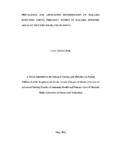PREVALENCE AND ASSOCIATED DETERMINANTS OF MALARIA INFECTION AMONG PREGNANT WOMEN IN MALARIA EPIDEMIC AREAS OF WESTERN HIGHLAND OF KENYA.
Abstract
Globally malaria in pregnancy continues to cause important public health concern for health care sector. Apparently, the disease remains to be a major determinant of maternal morbidity and mortality. In Kenya malaria infection in pregnancy is 18% while in Mt. Elgon Sub County malaria in pregnancy is unknown. It remains unclear which factors are associated with malaria in pregnancy in the highland epidemic prone areas in Western Kenya. Therefore, this study sought to determine prevalence and associated determinants of malaria infection among pregnant women in malaria epidemic areas of Western highland of Kenya specifically in Mt. Elgon Sub-County. Cross sectional analytical design was adopted and mixed methods used for data collection. For quantitative data collection, structured questionnaire was used to collect primary data from pregnant women who attended ANC in the selected health facilities. Qualitative approach adopted interview guides that targeted key informants in the health facilities. The information from the two methods were triangulated. Simple and systematic random sampling method was used to select health facility and participants. Laboratory tests were carried out by a qualified laboratory technologist using Rapid Diagnostic Test and microscopy for confirmation of Plasmodium falciparum. Response rate was 92.2%. The study results revealed that 16.2% of 389 respondents had malaria in pregnancy. Two thirds of women aged less than 25 years (67.3%, n=262) had positive malaria results compared to those aged > 25 years (33.7%, n=137). The determinants of malaria in pregnancy with statistically significantly association were: place of residence (OR: 5.7; 95%CI: 2.6 – 12.4; p < 0.0001); those who tested positive in the last 2 years (OR: 1.7; 95%CI: 1.0 -2.9; p=0.05); preferred shape of ITN’s (OR: 3.8; 95%CI: 1.5 – 9.7; p = 0.008); earth floor (OR: 1.8; 95%CI: 1.0 – 3.1; p = 0.03); mud wall (OR: 1.8; 95%CI: 1.0 – 3.1; p = 0.03); methods used to deliver health education (OR: 4.4; 95%CI: 1.6 -12.3; p = 0.007). Key informants blamed MiP on current policy that does not encourage the use of IPT in malaria prevention among pregnant women in the study area. In conclusion, age, place of residence, testing positive in the last 2 years, preferred shape of ITN, earth floor, mud wall and health education were identified as the most important determinants that were associated with MiP. Policy regarding non-use of IPT as a preventive measure could have contributed to reported malaria prevalence among such vulnerable group in the study area. The study recommends Bungoma County government to promote use of ITNs and preferable rectangular ITN’s by ensuring they are translated to appropriate use, Educate and empower the residents on available income generating activities which could enable them to get funds for building improved housing which have floor made of cement while roof made of iron sheets. Thus play a major role in protection of pregnant women against malaria. The County Government through Department of Health should create awareness by use of print media to compliment the current malaria control measures. WHO and Kenyan Government should review IPTp-SP policy in the study area.

